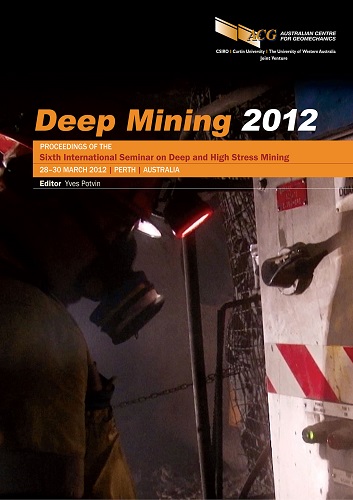Visualisation of elastic numerical modelling results for effective mine planning and design

|
Authors: du Plooy, K; Basson, F |
DOI https://doi.org/10.36487/ACG_rep/1201_25_duplooy
Cite As:
du Plooy, K & Basson, F 2012, 'Visualisation of elastic numerical modelling results for effective mine planning and design', in Y Potvin (ed.), Deep Mining 2012: Proceedings of the Sixth International Seminar on Deep and High Stress Mining, Australian Centre for Geomechanics, Perth, pp. 347-355, https://doi.org/10.36487/ACG_rep/1201_25_duplooy
Abstract:
One of the challenges that geotechnical engineers are faced with today is how to present numerical modelling results in an effective manner. The elastic BEM software, Map3D-SV, has been the trustworthy stress modelling software of choice to operational and consulting geotechnical engineers for many years. Through a process of back analysis, elastic modelling stress results can be effectively used on mines where rock stresses contribute to observed failures. Conceptual Map3D models also provide useful insights into the likely stress distribution around underground excavations that can be used to direct mine planning from conceptual study through to the operational phase. Map3D results are typically displayed as flat contoured surfaces on grids placed at the area of interest. This has proved to be largely ineffective when the aim is to capture the volumetric implications in a three dimensional mining environment. Other visualisation techniques such as iso-surfaces and colour mapping of results on excavation surfaces are far superior, but not yet supported in the Map3D-SV. This paper discusses visualisation techniques and demonstrates potential application areas for each: Excavation surfaces can be colour mapped according to results from points generated at a predetermined density, and a fixed distance from excavation surfaces for detail. The visualisation techniques discussed in this paper have been found useful in both feasibility studies and operational investigations. They are superior to flat contours in many instances, but especially where a global understanding of the stress impact, or the selected design criterion, is required. Other benefits that flow from these techniques are:
References:
Basson, F.R.P. and Schwab, N.M. (2001) Overcoming Limitations of Current Numerical Modelling Software for Complex, Three Dimensional Mining Geometries, Association of Mine Managers of South Africa.
Cleveland, W.S. (1994) The Elements of Graphing Data, Hobart Press, Summit, New Jersey, USA.
De Bruyn, I., Mylvaganum, J., du Plooy, K., Price, J., Baczynski, N. and Coulthard, M.A. (2009) Numerical analyses for evaluation of pit wall stability and stresses resulting from proposed underground mining excavations beneath the Ok Tedi open pit, Papua New Guinea, International Symposium on Slope Stability in Open Pit Mining and Civil Engineering 2009 (Slope Stability 2009), Santiago, Chile, November 09–11 2009.
Graf, C.C. and Basson, F.R.P. (2010) Managing Stress and Ground Condition Changes with Increasing Depth at Callie Underground Mine, in Proceedings Second Australasian Ground Control in Mining Conference, P. Hagan and S. Saydam (eds), 23–24 November 2010, Sydney, Australia, pp. 119–125.
© Copyright 2026, Australian Centre for Geomechanics (ACG), The University of Western Australia. All rights reserved.
View copyright/legal information
Please direct any queries or error reports to repository-acg@uwa.edu.au
View copyright/legal information
Please direct any queries or error reports to repository-acg@uwa.edu.au